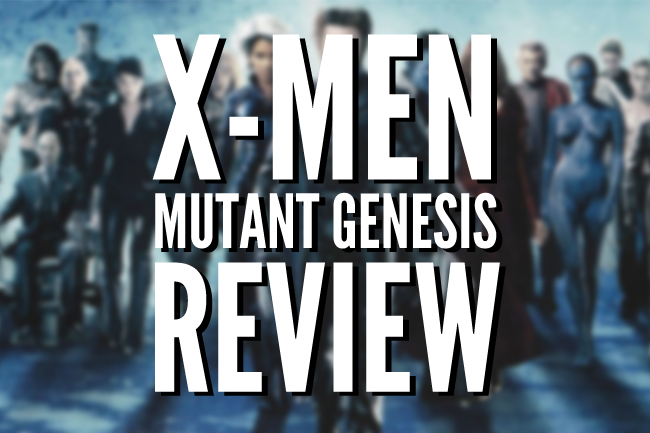X-Men: Mutant Genesis Review
January 7, 2016
Last time, I discussed an individual female superhero — Batgirl. Now I’m tackling the whole new playground that is a superhero team. So, because of my love for both DC and Marvel you think my favorite superhero team would be the Justice League or The Avengers right? It’s actually the X-Men. Why? The X-Men are not just characters I grew up reading and watching but ones I could relate to. For those who who don’t know, the X-Men are a team that consists of Mutants, people who at birth can inherit the X-gene, a gene that corresponds with their DNA to give them their own kind of superhuman ability. Mutants are feared in society for being different then normal people. The X-Men fight for the beliefs of living in a more peaceful society where humans and mutants can co-exist.
The X-Men are one of the most recognizable comic book superhero teams, they have some of the best comics, movies, and video games (eehh… sort of). Out of all the X-Men comics made none can match in hit and miss quality then the comic collection known as “X-Men: Mutant Genesis”.
“X-Men: Mutant Genesis” is written by Chris Claremont and Jim Lee with art provided by Lee including writers John Byrne and Scott Lobdell. Before the main book, a little backstory — in the late 70s and throughout the 80s, the once failed title “The X-Men”, re-named into “The Uncanny X-Men” became a big hit garnering critical acclaim and gaining financial success. By the end of 1990 Marvel had launched 6 X-titles. Marvel decided to launch another book with just the title “X-Men” — or “adjectiveless X-Men”, as fans called it, which is what I’ll be calling it for the rest of the review. When the first issue of “adjectiveless X-Men” was released, it did so well that it achieved a Guinness World Record for the best-selling comic book of all time. The book’s success paved the way for more X-Men spin-off books and eventually led to the downfall of the comic industry… But that’s a story for another time.
A few years later, they released the first seven issues of “adjectiveless X-Men” as a comic collection with the sub-title “Mutant Genesis”. With all that information out of the way, onto the book itself with its first three issue story arc “Rubicon” written by Chris Claremont and Jim Lee with art provided by Lee. When the Earth is threatened, Magneto returns along with a group known as The Acolytes, who put themselves as followers to the recurring X-Men villain. Featuring the return of Magneto, the addition of 15 X-Men, and the rise of new villains. Will the X-Men be able to stop the Acolytes and Magneto with a lot more at stake? or Will the X-Men perish?
Issues #4-7 are written by Jim Lee with art provided by Lee once again. The dialogue was written by John Byrne and Scott Lobdell. This next story is a Wolverine and the X-Men centered story. A figure from Wolverine’s past has returned known only as Omega Red. With a few old villains returning, kidnap him. With no other options the X-Men split into two teams, The Blue Team and The Gold Team. The Blue and Gold Teams were a concept introduced in both “The Uncanny X-Men” and “adjectiveless X-Men”. The idea was that since there was a large amount of X-Men there would be two separate teams handling different problems and situations. The Gold Team would be featured in “The Uncanny X-Men”while The Blue Team would be featured in “adjectiveless X-Men”. The Blue Team consists of: Cyclops, Wolverine, Psylocke, Gambit, Rogue, Beast, and the at-the time new addition Jubilee. As the Blue Team try to rescue Wolverine a new character pops up known as Maverick, another figure from Wolverine’s past who strangely has his own mysterious past. With the return of past villains and a new one, new characters, and more details on Wolverine’s past. Will the Blue Team rescue Wolverine? Who is Omega Red and Maverick? and Who are the returning villains?
The writer, Chris Claremont is well known for writing not only some of the best X-Men stories but some of the best superhero comics. Chris Claremont is one of the definitive writers for the X-Men. By the time Marvel had launched “adjectiveless X-Men” in 1991 Chris Claremont was originally supposed to write both “The Uncanny X-Men” and “adjectiveless X-Men” at the same time. But, because of arguments with both himself and the editor, he left “adjectiveless X-Men” after Issue #3. It was sad to see Claremont go especially after a long run as the writer on the X-Men. He defined a generation of fans of what the X-Men are. But for a final story such as “Rubicon” — is it worth the read?
“Rubicon” as Chris Claremont’s final X-Men story is a pretty good finale, but it does suffer from some problems. First off, while this story is written well, it suffers as being a follow-up to the previous story “The Muir Island Saga”. Not to mention “Rubicon” makes many references to past X-Men stories. The problem with this is readers would only understand these references if they’ve read past X-Men stories that these references are referencing. If Marvel wanted “adjectiveless X-Men” to be a jump on point for readers to get into the world of X-Men, then they would have done a better job handling the references. Marvel honestly could’ve started and ended “Rubicon” in “The Uncanny X-Men” and it wouldn’t have made a difference. Plus wouldn’t it have more sense to just continue this storyline in “The Uncanny X-Men” then introduce the second X-Men book after “Rubicon” ended? Anyway, the other problem is the dialogue. It’s not poorly written, far from it but when i’m reading it it feels really tiring to read at times. Sometimes the dialogue feels overexplained like in the first part of “Rubicon” when they’re explaining how each character’s powers work. While i do feel as the powers do need an explanation of sorts they don’t need to go into too much detail.
But, despite the problems there are a few positives i can give. For one, the characters are written very well. That’s one of the things that made Claremont’s writing strong. He understood the characters personalities and it’s in here too. As a final story for Magneto (Before he made his eventual return) it was told well. It had a large impact on me just as much as Claremont’s previous X-Men stories did before. With “Rubicon” being somewhat of a strong start to “adjectiveless X-Men”. How does it’s next story arc fair with “Rubicon”? and How was Jim Lee’s first outing as both writer and artist?
The second writer and artist is Jim Lee. Jim Lee by 1991 had built himself up as a comic artist working on issues of different Marvel series and “The Uncanny X-Men”. So it would only make sense for him to jump over to “adjectiveless X-Men”. (Plus he became very popular with readers by that point.) While his art for both “Rubicon” and his own story arc is very good it does have it’s detractors. Let’s talk about the positives before I get to the negatives.
For one, Jim Lee’s re-designs of the characters are great. The new colors and patterns on each of the character’s costumes help make them stand out and give them their own distinguished identities. The portrayals of the characters look dynamic, action-packed, and very much like how a superhero comic book is supposed to look like on some levels. Another positive is the layouts those are done well.
On to the negatives. Like I said before, Jim Lee’s portrayals of the characters are dynamic and action-packed, but that’s also the problem. When there’s a transition from an action-packed scene to something more quiet, it doesn’t seem to flow through very well. Another problem is that, while the re-designs are for the better in some areas, there are just a few additions that aren’t needed that make them from me completely loving them. Like the addition of the X symbol on their costumes. It makes sense to have the X symbol on their costume on their belt or on the right side of the chest. But they added it to the shoulders and make them huge. There are also extra shoulder and leg pads that aren’t needed. There’s also the addition of pouches which serve no purpose. Little touches like that annoy me. Lee’s art also suffers from the lack of backgrounds and detail in some panels. But you could make the argument that this was due to the printing technology of the time since it couldn’t input a lot of colors or details yet. They thankfully would fix the transition and background problems in the updated “X-Men: Mutant Genesis – 2.0”.
Jim Lee’s Wolverine-centered story unfortunately does not make it’s mark as “Rubicon” did. While I was reading this story after finishing “Rubicon”, it didn’t feel like the impact made by “Rubicon” carried over, as characters seem unaffected by the death of Magneto. It also feels like this didn’t reach the same story-driven edge “Rubicon” did in a sense nor make a memorable impact. To me, it feels forgettable like when Wolverine is trying to remember his past.
“X-Men: Mutant Genesis” has more misses then it does hits. Sad to say this especially since this book is visually impressive. I know a lot of hard work went in to this but had there been more heart in the story especially the second story this could’ve been on par with some of Claremont’s earlier X-Men work. But this is one of those books that is sadly a skip.





